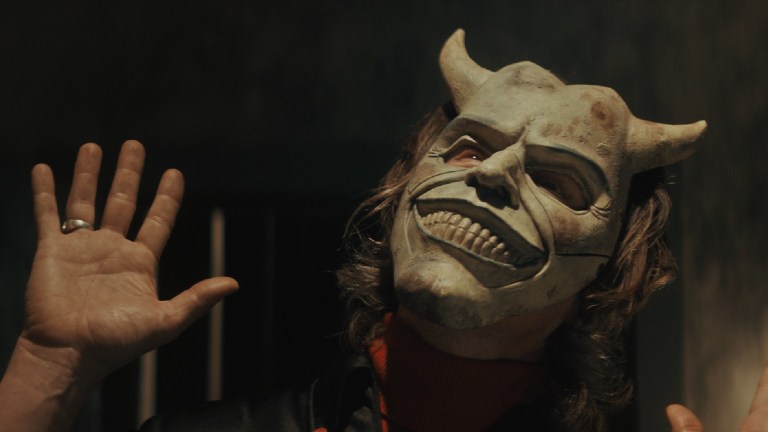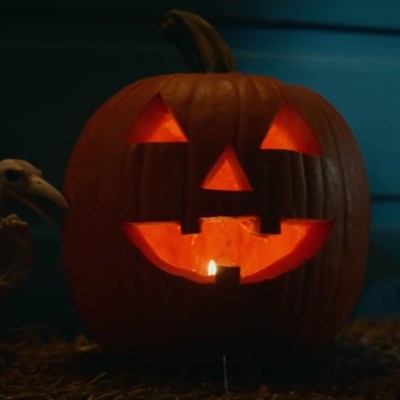Why Ethan Hawke First Said No to The Black Phone
Star Ethan Hawke and director Scott Derrickson tell us why they dialed into The Black Phone.

The Black Phone, the new horror movie out from Blumhouse and Universal Pictures, is a reunion of sorts: directed by Scott Derrickson, written by Derrickson and C. Robert Cargill, and starring Ethan Hawke, it’s the same principal talents who last came together for Derrickson’s acclaimed 2012 horror film, Sinister (which was also produced through the Blumhouse brand).
The Black Phone is the kind of intimate horror tale that Derrickson has done his best work with in films like Sinister and The Exorcism of Emily Rose, and it’s also got the added pedigree of being based on a short story by celebrated genre author Joe Hill. But there was one problem when the picture started coming together: Hawke didn’t want to do it at first.
“I felt really proud of Sinister and wanted to work with [Derrickson] again,” the actor tells us on the phone. “He called me up and said he had this other movie that he really loved and really wanted to make, but he wanted me to play somebody called The Grabber, who abducts children. I said, ‘There’s no way I’m going to play that part.'”
What Is The Black Phone?
Hill’s story and Derrickson’s film both center around Finney (Mason Thames), a 13-year-old boy growing up in a northern Denver suburb in 1978. The area has been subjected to a rash of child abductions by a mysterious figure who ends up getting the nickname The Grabber. When Finney himself is seized by the Grabber, his only chance at getting out alive depends on a series of calls he gets on a disconnected rotary phone in the Grabber’s basement, through which the killer’s previous victims speak.
Hawke was hesitant at first to play a character as irredeemably malevolent as the Grabber, who wears a mask throughout the film and whose name and motivations are never revealed. “I was just like, ‘No way, Scott… Got to get a better part for me than that.’” Hawke recalls. “But he said, ‘Well, just read it.’ I read it and was moved by it.”
Derrickson and Cargill took Hill’s story and expanded upon it, creating a portrait of suburban life in the late 1970s (Derrickson himself grew up in the Denver area around that time) with its paranoia, atmosphere of danger, and also vague sense of freedom. They also developed the lovely relationship between Finney and his younger sister Gwen (Madeleine McGraw), who is fiercely protective of her brother as they both navigate school, bullies, and their own abusive father (Jeremy Davies).
Hawke says that the central story of Finney and Gwen is what drew him in and ultimately changed his mind.
“The story of these young people, I just liked it,” Hawke says. “So I thought, ‘Well, wait a second, why won’t I play this part?’ I should do something that I haven’t done before. I’d never worked with a mask. The whole thing was just new to me and fun. I thought, ‘Well, why don’t I just try it?’ And if I was ever going to try something like this, the person to do it with is Scott.”
Who is the Grabber?
“Ethan and I, we’ve stayed friends,” says Derrickson about reteaming with the actor. “There’s just so much trust there between he and I. His trust in me as a director, my trust in him as an actor—we really just let the other person do what they do well, and it all came together quite nicely.”
Derrickson adds that keeping the Grabber’s backstory vague was a deliberate choice.
“I think that Ethan probably had some ideas,” the director recalls. “We know that he lived in that house since childhood. That’s really all we know. You can infer all kinds of things from that. You can make up your own stories, but I think there’s a mystery to evil. I think that what makes these kinds of sadistic serial killers fascinating is their alien nature. People in real life who have no empathy and no conscience are fascinating because they’re inexplicable… the more mysterious the Grabber is, the scarier he is.”
Hawke agrees with Derrickson’s assessment that it’s more effective to know as little about the Grabber as possible.
“There’s not much in the story or in the movie,” he says. “I think the more mysterious and unknown The Grabber is in a way, the more terrifying he is. I tried to come up with his story of that basement and that phone and why he likes black balloons and how he got into magic, and why he does this. You could come up with how he was raised and you can study serial killers and get into their crazy methodology. But what I started to think about is that this is a person whose brain is broken.”
Masking Up
One of the most unusual and unnerving aspects of the Grabber is his mask—or shall we say, masks. The monster wears a total of three masks, but each has a top and bottom section that can be removed or switched out. We never see his full face, but the way he combines the masks provides an eerie glimpse into the Grabber’s moods and responses in that moment.
“The decision to split the masks was a decision I made during pre-production,” explains Derrickson. “Honestly, it was driven by the fact that I had Ethan playing the villain. I thought, I want to be able to see him at least a little bit, but then it became a real storytelling point, and I realized I could design these masks in a way that the selection of what piece he wears and when has meaning.”
For the star it was both a challenge and opportunity.
Says Hawke, “It felt entirely unfamiliar to me, because 90 percent of the tools that you use as a performer are robbed from you. It felt almost like a Greek theater piece. I’d go down to this basement set and say all these weird lines, but I’d have a mask on. I was never sure if a scene worked or didn’t work, because one of the most interesting things about wearing a mask is how it makes other people feel. It changes the way other people relate to you… it makes the audience really focus on your vocal performance because they’re looking for any cues of how they can read it.”
The Kids Are All Right
The person whose responses Hawke was most concerned about was Mason Thames, the young actor making his film debut as Finney and thrown into the deep end with this terrifying, disturbing narrative.
“I didn’t really know how to work with a young person, doing such volatile, creepy material,” admits Hawke. “I was nervous about it at first, but this young kid had such a beautiful sense of play… I was worried at first about scaring him or anything, but he was all in. He wanted to go for it. I was proud of him. But you know what? It was interesting how much more he knew about movies than I did at his age.”
“He’s a brilliant actor and a good kid,” concurs Derrickson about his young star. “We read every actor his age that we knew of in New York and LA. Didn’t find anybody that I thought was good enough. He was, I think, in Texas, and just did a self-tape that made its way to the casting director who saw it, thought it was really good, and sent it to me. I [saw it and] thought he was very special. Then I did several online auditions with him and really became convinced that I had found a very unique, raw talent. I think Mason’s going to be a movie star as he gets older.”
Derrickson is equally full of praise for Madeleine McGraw, who plays Finney’s 11-year-old sister Gwen. Foul-mouthed, rebellious, and ferociously protective of her more socially awkward brother, Gwen challenges anyone who pisses her off, ranging from school advisors to police officers to God. “I just saw her audition tape and I was like, ‘Oh my God, that’s the girl,’” says the director, who adds that he delayed the start of shooting due to McGraw being committed to another project.
“I got the news, they said, ‘You’ve got to recast Gwendolyn Shaw,’” continues Derrickson. “I was like, ‘I’m not re-casting her.’ So I called [producer] Jason Blum and said, ‘I’m not making this movie without her… I want to move to the new year.’ And he is like, ‘For a nine-year-old girl?” And I was like, ‘Yeah, for this nine-year-old girl.’ She was that good. So we moved the whole production about five months just so that she could be in the movie.”
A horror Tale with Heart
Like Hawke explained earlier, Derrickson says that the empathetic nature of the original story, to which he and Cargill added the heartfelt and poignant relationship between Finney and Gwen, is what drew him to the material despite the fact that child abductions and murders is about as grim as a narrative can get, even within the horror genre itself.
“One of the fascinating elements of Joe Hill’s short story was that here was a story that, in terms of the content, couldn’t be grimmer,” Derrickson explains. “Yet even the short story was really empathetic, and really told with a feeling of love and a sense of hopefulness and justice, because of the ghost victim that would call Finney on the phone. I just found a lot of what made the story so fascinating was that combination of the incredibly dark, horrific and grim, and the incredibly beautiful and hopeful.”
The Black Phone is out in theaters Friday (June 24).


